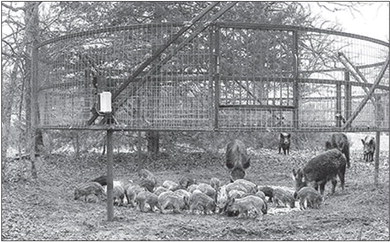Harvest of feral hogs now illegal on many public areas

Harvest of feral hogs now illegal on many public areas
Game & Fish regulating Wildlife Management Areas to control wild pig population
keith.stephens@agfc.ar.gov
LITTLE ROCK – In an effort to eradicate hogs, the Arkansas Game and Fish Commission has passed regulations against hunting them on wildlife management areas it controls. The regulation was enacted on some WMAs during the 2014-15 hunting season, and has gradually spread to include nearly all AGFC WMAs in the state.
At first glance, it does seem a bit backward that the AGFC is working to eliminate hogs on property it controls, but will not allow hunters to harvest them, but the situation is much more complex than killing a couple of pigs.
For decades, the AGFC allowed harvest of feral hogs during any open season with weapons legal for that season on wildlife management areas. Coyote season enabled hunters to be afield nine months of the year with high-powered rifles to pursue feral hogs. But feral hog populations continued to rise.
“Hunters were not able to harvest enough hogs to keep the population in check, and the idea of a near year-round hunting season on public land may have caused some hunters to dump hogs on new areas in order to hunt them later,” said Brad Carner, chief of the AGFC’s Wildlife Management Division. “We have to change the direction of feral hog management on our properties, and trapping has shown much more effective at removing hogs completely from a property.”
Complete removal is the key to hog eradication. Pigs are so prolific that unless 70 percent or more of a population is removed, the pigs that are left will repopulate the area within a year. “Sows can have two litters per year with up to a dozen piglets per litter, and a young female is sexually mature at six months old,” said J.P. Fairhead, feral hog program coordinator for the AGFC. “Shooting one or two hogs during a hunting season really has shown to have little to no effect on the overall population.”
In fact, shooting a few hogs may actually hurt the situation. AGFC biologists have switched their tactics toward setting large corral traps on WMAs and areas with large hog problems. Instead of trying to catch or shoot one or two pigs and scattering the rest of the pigs on the area, biologists are baiting entire family groups of pigs into the traps and eradicating dozens at a time.
“We have removed 6,802 hogs on our areas since 2013 through this new trapping method,” said Fairhead. “But our trapping efforts are almost nothing when the pigs are constantly disturbed by people hunting them. We need the pigs to be relaxed before they become susceptible in the large groups we need to make a dent in the population.”
Some WMAs owned by other agencies, but cooperatively managed by the AGFC for hunting still allow hunters to take a hog if it crosses their path during a firearms deer, bear or elk season, as manpower for trapping in those areas can be limited.
“We have tried to gradually phase hunters into the new philosophy of not shooting hogs on our WMAs,” said Jeff Crow, AGFC director. “During the first year, many areas owned by the (Army Corps of Engineers) still maintained the old standard of allowing hunting during any open season, but they have also adopted the method of only allowing harvest during firearms deer, bear or elk seasons. He hope that the continued limitation of hog hunting on public lands will prevent more illegal dumping of hogs on public land for sport.”
These regulations concerning hog hunting on individual wildlife management areas were changed during the annual regulations cycle in May. However, much of the focus on regulations during that time frame were focused on the recent discovery of chronic wasting disease in Arkansas and on changes to mechanical decoy regulations and access times on WMAs for waterfowl season.
Crow says regulations may be somewhat difficult to interpret, but AGFC staff continues to make an effort to lessen the learning curve. “We understand that this is a new way of thinking that goes against what we’ve had in place for decades and our wildlife officers have been asked to show discretion in issuing warnings or citations about hog hunting on these WMAs,” said Crow. “But we have seen enough positive results from the trapping efforts when the pigs are not spooked by hunters to continue this new course of action to eliminate hogs currently on our property and remove the incentive for hunters to dump more on public land in the future.”
Visit www.agfc.com/hunting/ Pages/HuntingRegulati onsFeralHog.aspx for more information on feral hog regulations and the threat they pose to native wildlife and habitats.

From Keith Stephens


Share